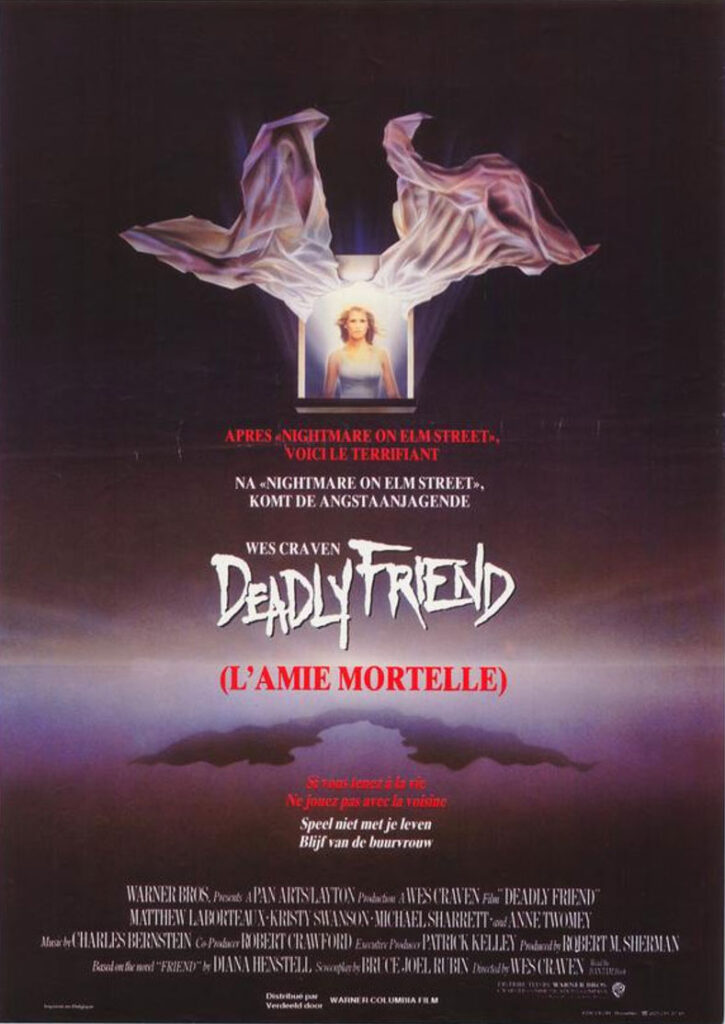Warner Bros. did Wes Craven dirty. Deadly Friend, from 1986, was Craven’s first feature since A Nightmare on Elm Street, which made a bucketful of money for New Line Cinema. Warners didn’t have the confidence in Craven that his previous success had earned. After a first cut of this film was poorly received by a test audience, producers and studio execs ordered reshoots. Nothing new there, but as originally shot, Deadly Friend was not a horror movie. It was a sci-fi thriller. Craven was forced to change the story, add in blood and gore scenes, and turn his film into something against his and screenwriter Bruce Joel Rubin’s intent.
Deadly Friend follows robotics and neuroscience prodigy Paul (Matthew Labyorteaux) and his mother, Jeannie (Anne Twomey), as they settle in at fictional Poly Tech West. Paul already has a jump on his research, having built an autonomous, self-contained AI-controlled robot called BB, voiced by Charles Fleischer (channeling, bizarrely, Gremlins). BB is a prototype, the idea being that, someday, Paul will discover a way to integrate computer chips into the human brain, for science and medical stuff. If that seems to viewers like foreshadowing, that’s because it is.
Paul’s new neighbor is high school teen Samantha (Kristy Swanson). The two take an immediate liking to each other, but there’s a catch. Sam’s father, Harry (Richard Marcus), is an abusive alcoholic who exercises total control over Sam’s life. It’s implied that the abuse might be sexual. After Sam spends an evening with Paul, Harry is in a rage and pushes  Sam down some stairs. Her injuries are so severe that she is declared braindead, and removed from life support.
Sam down some stairs. Her injuries are so severe that she is declared braindead, and removed from life support.
Paul decides to apply his research, and implants tech from BB, who had earlier been destroyed by a crotchety neighbor from across the street, Elvira (Anne Ramsey). The chip works, in that Sam awakens, but all Paul has managed to do is turn his crush into a zombie. Soon after, Sam’s walking corpse goes on a killing spree, doing away with those who have wronged her or Paul. In the final act, Paul, who has been sheltering his Frankensteinian creation, must decide what, if anything, to do about the situation.
Despite being messed with by the people in suits, Craven managed to tell a coherent story. It follows a classic three act structure. Setup, conflict, denouement. This is in contrast with the general consensus amongst critics that the movie was somewhat scatterbrained. I never got that sense. To me, it’s a consistently told story, without many telltale signs that it was chopped up. There is only one scene, a dream sequence where a gory Harry terrorizes Paul, that doesn’t fit the narrative. Craven did a good job bowing to the wishes of the money people. Sure, it screwed up the movie he wanted to make, but it didn’t ruin the movie he did make.
Unlike some of his earlier films, Deadly Friend is a character-driven movie. Of course this has to do with the film’s original intent. When he turned this movie into horror, though, Craven carried all that character development and the dynamic interactions between Sam and Paul over. It served the story well. We get to know Paul and Sam, and, to a lesser extent Jeannie and Tom (Michael Sharrett), another new friend Paul makes in the neighborhood. There’s a humanity to all these characters that often gets lost in normal horror shoots, where these characters would be marked as either a victim or a survivor. Craven and Rubin were incentivized in the original story to make these people seem real. The performances are good, too, although Swanson appeared to have a bad case of rookie jitters.
If one wants to look at this film through a modern, political lens, it has a lot to say about bodily autonomy. Sam has none in her home, and the one person she trusts in her world ignores her autonomy and brings her back to a semblance of life without ever bothering to consider Sam’s wishes. Since Deadly Friend is from 1986, I doubt much thought was given to this glaring aspect of the movie, but it very much makes this a body horror flick, among the other horror subgenres included.
Deadly Friend is not a great film. As an artifact of the trials and tribulations of the filmmaking process, it’s quite interesting. So many other movies with similar production issues go flying off the rails, but I believe Craven kept his movie tight and under control. The result may not be spectacular, but I can’t help but be impressed by how well it works. This middle of the road horror flick should be bad, but it’s not. Funny enough, it’s the material from the original story, the one the suits didn’t want, that carries the film. That, and one of the more spectacularly bloody and outrageous death scenes in film history. Check it out.
